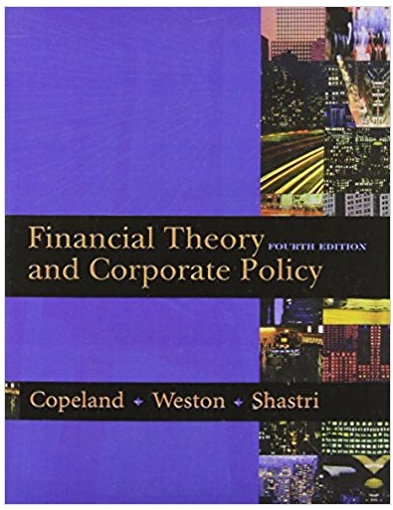Answered step by step
Verified Expert Solution
Question
1 Approved Answer
Some companies measure performance by requiring both top line growth and bottom line growth (growth in revenue and growth in net income). Is this performance
- Some companies measure performance by requiring both “top line” growth and “bottom line” growth (growth in revenue and growth in net income). Is this performance measure consistent with shareholders wealth creation? Why or why not? Illustrate your answer with relevant examples.
- Consider ABC Bank as an unlevered firm and firm KCB Bank as a levered firm with target debt-to-equity ratio (B/S) =1. Both firms have exactly the same perpetual net operating income, NOI = 180, before taxes. The before-tax cost of debt, Kb is the same as the risk free rate. The corporate tax rate is 30%. Given the following market parameters:
E (Rm) = 12%, δ2m = 0.0144, Rf = 0.06, Beta-B = 1, Beta-C = 1.5
- Find the cost of capital and the value for each firm.( Ignore any effect from personal income taxes)
- Evaluate the following four projects to determine their acceptance or rejection by ABC Bank and KCB Group. What do the results of this evaluation tell you about leverage in a world with corporate taxes but no personal taxes (Note: rjm is the correlation between the unlevered free cash flows of each project and market)
Project j | Cost j | E(NOIj) After- Tax | δj | rjm Correlation of j with the market |
1 | 100 | 9 | .10 | .6 |
2 | 120 | 11 | .11 | .7 |
3 | 80 | 9 | .12 | .8 |
4 | 150 | 18 | .20 | .9 |
Step by Step Solution
★★★★★
3.54 Rating (157 Votes )
There are 3 Steps involved in it
Step: 1
i Top Line Growth bottom line growth are equally important to in...
Get Instant Access to Expert-Tailored Solutions
See step-by-step solutions with expert insights and AI powered tools for academic success
Step: 2

Step: 3

Ace Your Homework with AI
Get the answers you need in no time with our AI-driven, step-by-step assistance
Get Started


